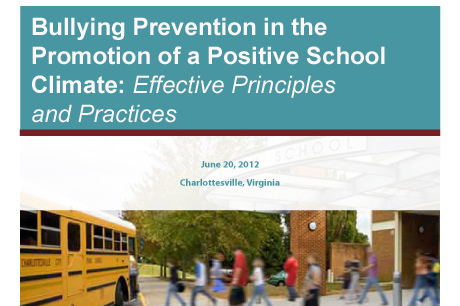Laurie Jean, Adolescent Educator at SARA, the Sexual Assault Resource Agency, gave us her thoughtful insights on the bullying prevention conference co-hosted by Youth-Nex, this summer. She was one of 500 teachers, law enforcement personnel and others, who attended the statewide event held at Charlottesville High School.
Related posts can be found under Bullying.
Walking past tables covered in white paper and coffee urns, I expected little from yet another conference as I entered the Martin Luther King, Jr. Performing Arts Center. I rarely find much useful substance amid conferences’ broad, non-targeted material. As I settled into a folding seat in the back of the theater, a wave of empathy for my students came over me as I recalled many of the sensations of attending a mandatory high school assembly. What I heard then was a wonderful wake-up in the dim lights of the auditorium: Dewey Cornell’s opening statement that we should expect some disagreement among the speakers that day. Conflict and debate?! Okay, I’m listening!
One of the great debates of the day was whether bullying prevention programs have reached a certain standard of effectiveness to move us into the future. Those of us who strive to bring violence prevention programs to public schools want the final solution now, and are sometimes willing to overlook evidence of ineffective programs to appease this deep longing of our souls. We want to be able to say: “Yes, I have found the answer to ending violence, and I will see it resolve in my lifetime.” But we all know that we’ll wade through many failed experiments first, and there will never be a one-size-fits-all approach, nor even one singular program or method that does it all. We’ll need a variety of efforts, fitted to specific communities, to create the change we desire.
I approach violence prevention with a public health and gender studies perspective. One principle of social change is that a community needs to be saturated with awareness and information, constantly provided with experiences that make them question the status quo and begin changing behaviors. The PBIS / Effective School-wide Discipline concept puts the principle of ‘saturation’ into practice – everyone must be on board and the school’s culture must be real for the students and adults in every part of their school experience. The difficulty here is clear: garnering buy-in from 99% of the community takes time that schools just don’t have. Now imagine that you have to get buy-in on a topic as hotly contested as gender (similarity, equality, norms…), and you can see that I have my work cut out for me.
Dr. Bradshaw encouraged us to focus on general positive development rather than siloed, topic-based programs, and to be careful how we allocate our time. Excellent advice. But do we have a complete, structured understanding of general positive development? What I find is that, in education, gender equality and harassment are often neglected, even though it impacts somewhere around 80% of the students in our schools (AAUW, 2005). For instance, Dr. Swearer presented a fantastic bullying intervention practice that has succeeded in responding to bullies, once caught. Yet there is no gender-based attitudes survey included in her battery.
Dr. Espelage provided some of the strongest and probably most complete perspectives for the audience. Promoting social-emotional learning and character education, she emphasized that bullying is ingrained in our society and can only be extracted through measures as advanced and complex as some of the most advanced surgeries of our day. When we talk to kids about standing up for themselves, what are we really expecting of them? Kids do say stop; many are assertive – the ones who would be, anyway.
Assertiveness is not going to be the central solution. Kids need life skills before anything else. Homophobic teasing is on the rise, and is causally linked with generic bullying: if a student engages in garden variety bullying in 5th grade, it will likely evolve into homophobic teasing in middle school, and then leads to sexual harassment. In communities where sexual harassment thrives, sexual assault also tends to occur more often. If you talk about bullying but not gender inequality, you won’t achieve much; bias-based bullying also needs to be addressed.
This conference was fantastic because it provided an in-depth look at where we are in bullying prevention, and the opportunity for all 500-some people present to consider where to turn next. Each presenter brought meaningful, promising methods for us to consider, and the variety gave us a chance to compare, and to consider mixing-and-matching for our own localized communities. The conference was co-hosted by the Virginia departments of Education, Health and Criminal Justice Services; the Albemarle/Charlottesville Safe Schools/Healthy Students Project; the Virginia Department of Education Region 5 Training and Technical Assistance Center at James Madison University; and Youth-Nex.
Conference presentations and other details can be found here.
